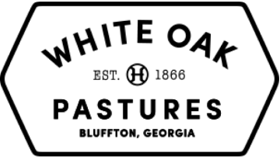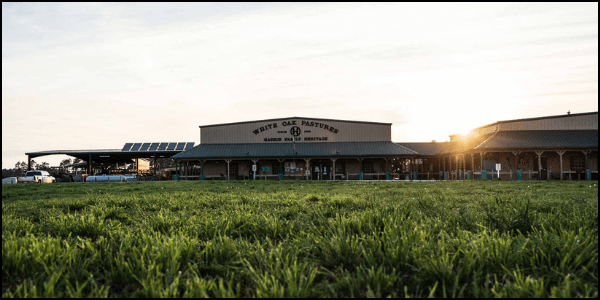We want to explain the complexity of regenerative agriculture.
The word “regenerative” is now entering the mainstream, with products on grocery store shelves and online stores starting to claim “regenerative practices”.
Currently, the main narrative around regenerative land management focuses on carbon sequestration. Many farms, including us, have highlighted how regenerative agriculture encourages beneficial carbon sequestration.
Carbon is certainly a natural starting point, because it is relatively easy to measure. However, as we watch the dialogue about regenerative evolve, we want to stress that the carbon cycle is one cycle among many.
At White Oak Pastures, we believe that regenerative land management is about restarting ALL the cycles of Nature that industrial farming has broken. Nature is complex; all of these cycles are interdependent on one another. Nothing is regenerative unless it helps ALL of the cycles function.
As a consumer, if you want to understand a farm’s environmental impact, you should evaluate the farm’s impact on multiple natural cycles:
- The Carbon Cycle
- The Energy Cycle
- The Water Cycle
- The Mineral Cycle
- The Microbial Cycle
- The Community Dynamics that tie these Cycles together
- (And there are probably many more cycles occurring than we even recognize)
As a consumer, you are making conscious choices about who you support with your food dollars. You want transparency in understanding how your food is produced.
“Regenerative” isn’t a regulated, defined term in food production. There are some new certifications, and generally accepted practices, but consumers need to grasp the different aspects of regenerative agriculture to understand the full picture.
All that we can talk about is what regenerating land looks like on our farm. Here, we try our best to explain the nitty-gritty details of what restoring the Cycles of Nature actually looks like in practice.
Introduction
Nature is complex, and its cycles aren’t isolated. We admit, it’s hard to break down Mother Nature into neat categories. What is good for the water cycle is good for the carbon cycle, what is good for the microbial cycle also benefits the mineral cycle. But by examining each cycle, you can start to see how they fit together.
We are cowboys, not scientists. We can only talk about what we see every day in our pastures as we raise our livestock and regenerate our land.
This blog post is made up of information from a 12-week social media series we called “Cowboy Science”. The videos and photos show how our farm’s regenerative land management imitates natural systems and maintains healthy cycles of Nature.
Warning: this is a lengthy series! Interested in a certain topic? Click below to skip to a section.
Water Cycle
Mineral Cycle
Microbial Cycle
Carbon Cycle
Energy Cycle
Community Cycle
The Water Cycle
Flood events show disparities in water cycle management
This video shows the difference between a functioning water cycle on White Oak Pastures land and a water cycle that has been broken by industrial agriculture. The video shows water flooding the side of the road after a 6-inch rain event.
LEFT SIDE: The water flowing from the left that looks like tea is runoff water from our pastures. Our fields have a well-established perennial plant root system holding the soil and preventing erosion, so the color comes mostly from tannin in the soil.
The water that flows off of our perennial pasture does not carry chemical fertilizers or pesticides to the ocean, because we do not use any. And the deep roots of our perennial grasses help keep valuable topsoil on our land (and help increase it over time), instead of letting it erode and wash away downstream.
RIGHT SIDE: The cloudy, red water is from a neighboring farm. The water is this color because it is full of eroded topsoil. This land is in constant monocultural row crop production during the summer, and it lies bare & unprotected in the winter. This farm is losing valuable topsoil every time it rains (and 1” of topsoil takes at least 100 years to form).
In addition, this neighboring farm uses copious quantities of chemical fertilizer and pesticides and tillage. This runoff water will flow through creeks and rivers until it ultimately flows into the Gulf of Mexico. The chemical runoff from monoculture farms plays a key role in destroying marine life and creating dead zones in the ocean.
This is a stark comparison of what a functioning water cycle looks like next to the industrial agriculture model.
Regenerative agriculture prevents erosion and restarts functional water cycle
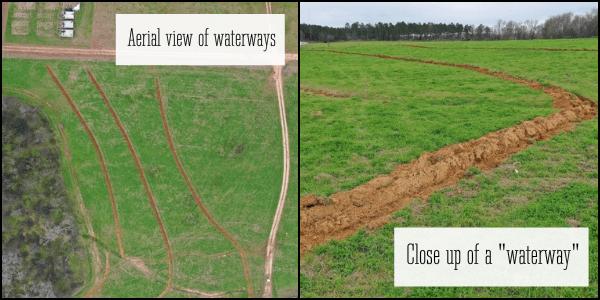
How do we restart the water cycle on new pasture?
The photos above show how we regenerate land that was previously monoculture crops (grown with chemical fertilizer, pesticides, & tillage).
A nearby family leased this land to White Oak Pastures. By the time we took it over, there were extreme erosion problems & less than 0.5% organic matter in the soil.
When we regenerate erosion-prone land, we use managed grazing & animal impact:
- We plant perennial grasses with deep roots, increasing the % of organic matter in the soil
- Deep roots & more organic matter increase soil’s capacity to absorb rainwater (each 1% increase in organic matter absorbs roughly 1 more inch of rainwater)
Normally, this perennial pasture is enough to reverse erosion. Unfortunately, this land required more extreme intervention.
We hired a professional surveyor, using the map to open up the land to create our own waterways.
- Slices of land allow the water to soak into the exposed soil, keeping water in the pasture and stopping the land-degrading erosion
- This helps establish more organic matter, starting a positive feedback loop of increased capacity for rain soaking into the land instead of running off
- With water stored in the soil, the land is also more drought-resistant
When we convert conventional row crop land into perennial pasture, we are changing how water functions on the land and effectively restarting the water cycle. We're also preventing destructive topsoil and mineral erosion.
Commodity monoculture farms use many practices that are not beneficial for water percolation. Tillage, shallow annual crop roots, and chemical usage starve soil microbes and compact soil over time.
As Will Harris says, “Monoculture fields are like we put a paved parking lot across 80% of our land. Unable to soak into the land, water carries away the organic matter we need in healthy soils, and it also carries the toxic chemical herbicides & fertilizers some use on our farms to the ocean.”
Read more about this process in our blog post about this parcel of land!
The Mineral Cycle
When we keep minerals in the soil, microbes, plants, and livestock benefit
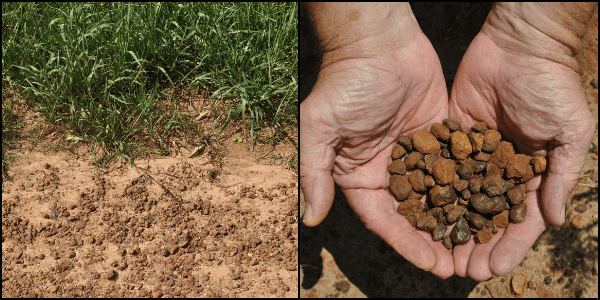
There aren’t many proper rocks in South Georgia, but “pebbly ground is the best ground”. Pebbles are a treasured source of minerals, key to a healthy, thriving ecosystem of plants, microbes, & livestock.
The cowboy science explanation: plants & soil microbes have a symbiotic relationship. Microbes chemically pull the minerals out of rocks (like lichens dissolving the surface of a boulder). Microbes want the sugars plants produce through photosynthesis, so they chemically trade the positively-charged ions of minerals, making minerals available to plants.
The minerals help a plant grow & perform its metabolic functions. If the plant is eaten, it passes minerals on to the animal. When the animal dies, microbes consume the minerals again, making them available to other plants.
Our regenerative & holistic practices support the mineral cycle in multiple ways:
- Probably our greatest contribution is that our regenerative practices promote microbial health (see section below). These microbes get the minerals into the plant so that they are not leached out of the soil.
- Our farm operates in a zero waste, closed loop system. Any part of the animal that we cannot sell is composted. We compost 9 tons of packing plant waste, five days a week. About a ton of this is bones, which are almost pure minerals, and the feathers & eviscerate also have a significant mineral content. We spread this compost on our land, returning minerals to the soil.
- We also grow hay under irrigation of mineral-rich water from a poultry rendering plant. We feed about five thousand 1,500-pound rolls of this hay to our cattle during the winter. In addition, we use a 24-option mineral cafeteria to enable our ruminants to adjust their own mineral intake.
- Our perennial pastures minimize soil erosion, keeping mineral materials on our land.
Our regenerative farming practices help the mineral cycle functioning on our land, as well as all of the interdependent cycles.
The Microbial Cycle
Perennial grasses and no tillage help keep microbial communities healthy
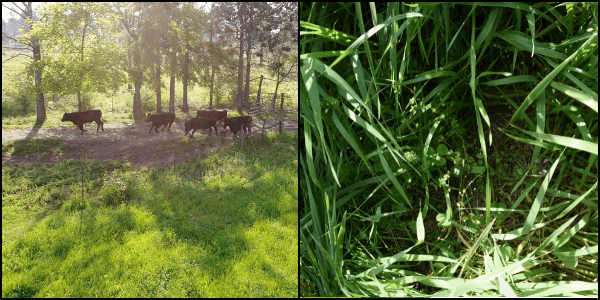
Our pasture soil is alive, teeming with microbes that are essential for soil health - plus the health of plants and our livestock.
Our perennial grasses (pictured above) have deep roots that break up compact land. These deep roots have a ton of different benefits, but in terms of the microbial cycle: deep perennial roots help create a healthy environment for a diverse community of microbes. Living roots feed soil microbes, and soil microbes feed living roots.
Microbes serve a ton of essential functions. Microbes mineralize the soil, protect plants from pests, aid in water percolation, aerate the soil, help make minerals and decaying plant/animal matter available to plants, and have way too many other benefits to mention (some benefits we probably cannot even recognize).
Think about your gut - we buy probiotics to maintain a healthy microbial population in our gut. And yet, industrial agriculture puts pesticides on our land to kill the healthy soil microbial populations.
There are lots of microbe killers in industrial agriculture: fungicides of course, but also insecticides, herbicides, nematicides, and anything that ends in “cide”. We do not use any of these chemicals on our pastures.
But in our opinion, there is also another great microbe killer: mechanical cultivation, like how monoculture farms till their land repeatedly throughout the year. Tilling, then only growing one species of crop during a season, takes its toll on soil microbes.
By maintaining perennial pasture, full of diverse plant species with roots staying in the soil year after year, we maintain a healthy microbial cycle on our land. And when the microbial cycle is functioning, it yields an abundance in plant life and impacts the water, energy, carbon, and other cycles. Nature doesn’t till, so neither do we.
We feed microbial health with application of manure and compost
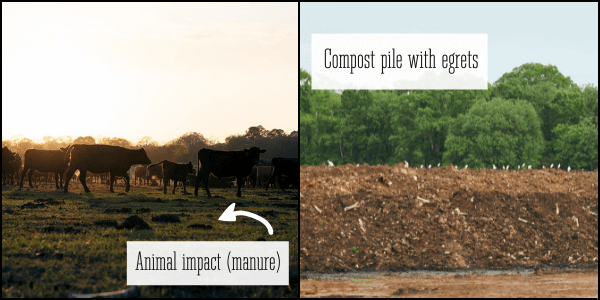
How else do we support healthy microbes in our soils? Animal impact and compost.
Microbial communities are the foundation of healthy soils. When the microbial cycle is functioning, it yields an abundance in plant life and impacts the water, energy, carbon, and other cycles. None of the other cycles operate properly if the microbial cycle is not fully functional.
Animal impact is essential to keep the microbial cycle healthy and functioning, because it provides nutrients (manure) for microbial communities:
- Ruminants eat perennial grasses and digest them in their 40-gallon portable fermentation chambers (otherwise known as their stomachs).
- The nutrients in manure are readily available to soil microbes because they are digested. If the plant material was not pre-digested by the ruminant, 70% of the nutrients would oxidize and never be made available to soil microbes.
Our farm also operates as a zero-waste system, where we compost anything we can’t sell and return that material to the land:
- Compost made from inedible bones and viscera provides nutrients that are readily available to microbes.
- This is a zero-waste nutrient stream (the opposite of a waste stream).
Will Harris:
“I used to buy chemical fertilizer, feed it to corn plants, then feed the corn grain to my cattle.
Now I make compost from the dead plant and animal material that I compost on my farm. Then I feed this compost to my soil microbes. The soil microbes feed my grasses, and the grasses feed my cattle. It is a helluva lot more resilient system.”
The Carbon Cycle
Adding carbon material to our pastures sequesters carbon and improves soil health
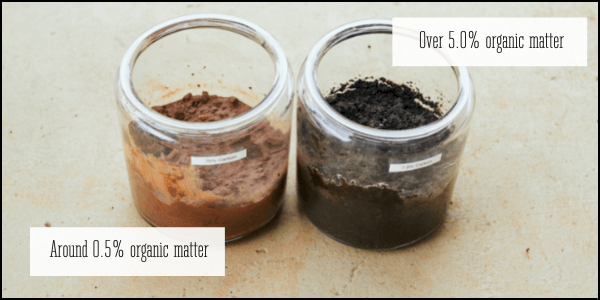
The image above is a side-by-side view of soil from two completely different production systems. Note: These samples were taken about *50 feet* from one another.
LEFT SIDE (red-tinted): soil with around 0.5% organic matter, taken from a neighbor’s farm who grows a monoculture rotation of corn, soybeans, and peanuts, relying on chemical inputs like fertilizers and pesticides
RIGHT SIDE (dark brown): soil with over 5.0% organic matter, taken from one of our perennial pastures, that has been under regenerative land management for about 20 years
Our regenerative agriculture model increases carbon material in the soil through perennial plants and animal impact. We are sequestering carbon in the soil through practices like:
- The establishment of perennial pastures
- The application of compost
- Emulating evolutionary grazing, using high animal impact followed by a long period of recovery (like wolves slowly pursuing large herds of bison across the Great Plains)
- Grazing multiple species of livestock, which all impact the land differently
- Not using tillage, pesticides, or chemical fertilizers
Because the Cycles of Nature are all interrelated, increased carbon material in the soil benefits every other cycle:
- This soil can hold more water, preventing erosion of topsoil and mitigating drought conditions
- A functioning carbon cycle helps plants provide more energy for microbes, creating a richer, healthier microbial environment
- A healthier microbial environment creates a positive feedback loop for plants, which results in more vegetative matter for livestock and wildlife to feed on
The Energy Cycle
Regenerative agriculture respects the energy cycle, creating an abundance
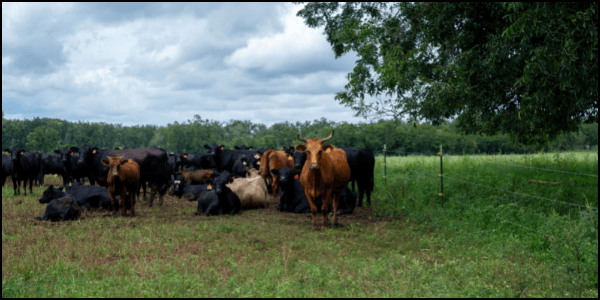
We think about the energy cycle a bit differently:
- The other Cycles of Nature are the perpetual transformation of the components that exist in the biome (water, minerals, etc)
- In comparison, energy is constantly being *introduced into* the biome by the sun
A properly operating biome captures energy through photosynthesis and uses it to fuel all other Cycles of Nature. If plant life is healthy, it will be transformed into an energy source that is the foundation for a thriving ecosystem.
We believe that regenerative land management and holistic grazing create a properly operating biome. It uses Nature’s energy cycle to produce an abundance, especially here in the fertile Gulf Coastal Plains.
Cowboy science explanation of how we respect the energy cycle on our farm:
- Perennial grasses cover our pasture year-round, turning sunlight into nutrition for our 10 species of livestock.
- Livestock fertilize the ground with their manure and their animal impact encourages more perennial grass growth.
- Any part of the animal we cannot sell is composted and returned to the land, contributing to other functional cycles.
The Community Cycle
Our holistic land management benefits the entire ecosystem, including local wildlife
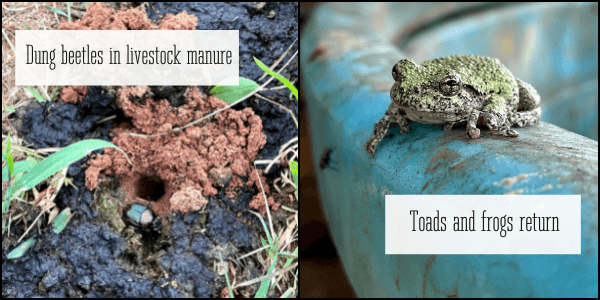
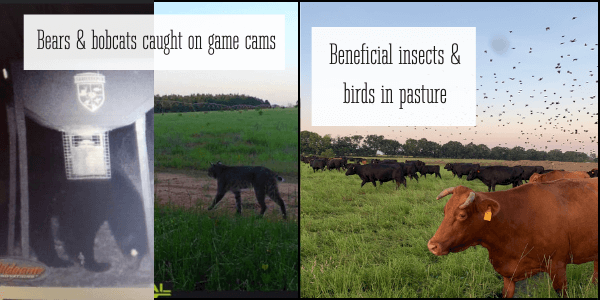
There are community dynamics that tie all of the Cycles of Nature together. On our farm, we mimic Nature to provide a healthy ecosystem for all species.
“When you manage for the benefit of one species,” says Will Harris, “you do so at the expense of all others.”
In other words, Nature abhors a monoculture. Whether you manage for just commodity corn, or just for commodity cattle, the monoculture starts to break down Nature’s cycles.
Our regenerative agriculture practices benefit the entire ecosystem. We view multiple animal species thriving on our land as a promising sign of abundance.
For example, when we establish perennial pasture, we start to notice some changes in local wildlife:
- Insects like dung beetles abound, keeping horn flies and face flies in check
- Many species of swallows swarm the pastures eating flying insects
- Wild birds like eagles move in a cycle with the pastured livestock
- Black bears are spotted on game cameras
- We get cattle egrets visiting from April to October (instead of June through August)
- Ibises appear for the first time ever
- Frogs and toads that had not been seen in a generation show back up
- Fireflies light up the night again
- Cicadas are deafening at dusk
We believe the community cycle also extends to our village of Bluffton, which changed from a ghost town to a thriving little destination, in only a decade.
Will Harris:
“Productive land is teeming with life, because all of the Cycles of Nature are operating optimally. When this occurs, the land produces an abundance that feeds all living things. It is solar energy converted into protein, fatty acids, and carbohydrates. It was the original source of the fossil fuels that were captured during the era of the dinosaur. This abundance is the only true wealth that exists on the Earth.”
When we manage land for the benefit of all species, not just one, all of these species help the Cycles of Nature function.
Our multi-species grazing model offers beneficial animal impact

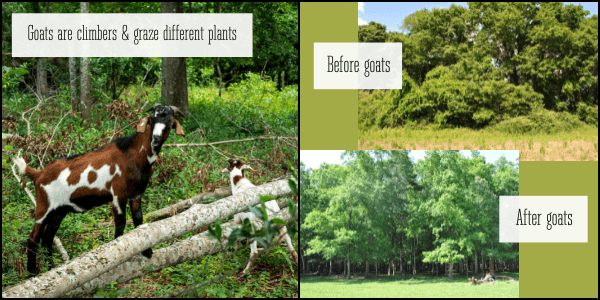
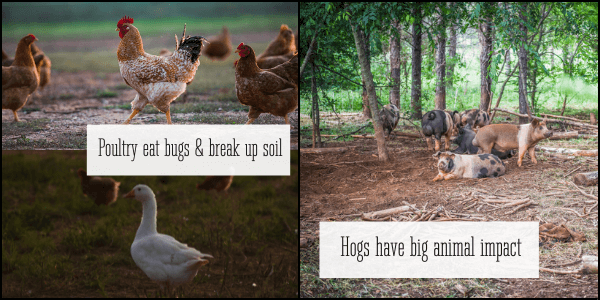
Our holistic, regenerative land management system relies on multi-species rotational grazing.
Each of our 10 species has a very different impact on the land, and the combined animal impact is powerful for land regeneration.
Certain situations as land heals call out for different animal impacts - this is the prescriptive use of our livestock.
Here is a BRIEF, high-level overview of how our different livestock impact the land, so you can start to imagine how the system works together - and why species diversity is key to land regeneration.
Cattle
- Cover a lot of ground & eat a lot of forage
- Mobile 40-gallon fermentation chambers, turning forage into microbe feed by adding manure back to the soil
- 1100-pound animals with cloven hooves break up soil caps, encouraging water percolation, aeration, and seed germination in natural fertilizer (manure)
Goats
- Climbers, reaching up to much higher foliage
- Eat woody shrubs that none of our other animals consume
Sheep
- Bite foliage down lower than cattle, eating different species
- Have an appetite for succulent shrubs (plants that need controlling, or they will outcompete our perennial grasses)
- Break the lifecycle of parasites that attack our cattle
Poultry (5 different species)
- Natural (& hungry) bug and grub control, helping keep our pastures free from insect overpopulation
- Usually follow our ruminants, helping keep down pests, worms, & parasites for other livestock herds
- Strong feet & beaks of our poultry scratch and peck the pasture, aerating the soil and encouraging water percolation
- Add much needed nitrogen and other nutrients to our soil
Pigs
- Big animal impact - our hogs help clear out some of the densest areas, like forest in former pine tree farms, opening up the forest canopy & allowing other plant species to grow
- Hungry omnivores that root down into the soil and add nutrients to our forests
Break the lifecycle of parasites that attack our sheep and goats
Multi-species grazing is a form of biomimicry, explored below.
Biomimicry of predator-prey movement supports all Cycles of Nature
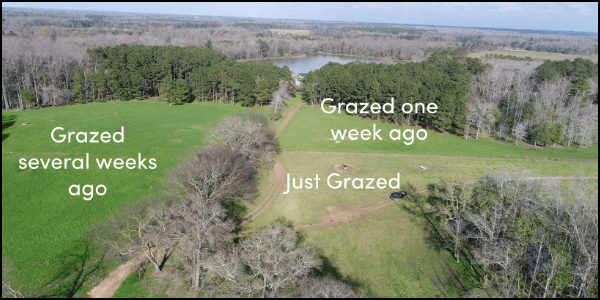
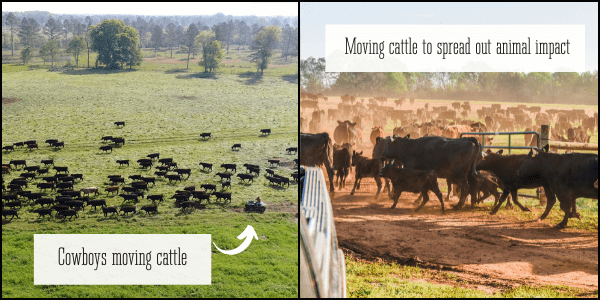
There is a natural community cycle in Nature, based on predator and prey movement. It is how some of the most productive ecosystems on Earth evolved.
This system was functioning in the Coastal Plains of South Georgia for a long time.
Predators (wolves or big cats) spent their lives slowly chasing their prey.
- By moving the grazers across the landscape, the predators prevented the big herds from overgrazing the landscape.
Herbivore grazers, like bison, stayed in tight formation as protection from predators.
- These grazers had a hard impact on the land, eating forage, digesting it, and defecating & urinating.
- Their hooves broke up the surface of the soil, pushing their waste and plant material into the soil.
Plants were grazed very short, because herds moved slowly, but the threat of predators kept grazers constantly on the move.
- Plants had time to grow, and microbes had the opportunity to thrive.
- The land had a long recovery period before another period of heavy animal impact, key to healthy plant establishment.
We use biomimicry on our farm today to emulate this natural evolutionary system.
- We replaced wood bison with cattle, sheep, and other livestock.
- We, the stockmen of White Oak Pastures, replaced the wolves and big cats, constantly moving our herds and flocks across the landscape.
- Our land is again becoming a beautiful savannah, with great hardwood bottoms.
Will Harris describes that while in college,:
“My professors taught that 'you cannot build topsoil in the Gulf Coastal Plains soils.' Unfortunately, I believed them for 20 years.
I finally learned that it’s true, you can't build topsoil - if you are using tillage, chemical fertilizer, and pesticides. But, if you give those industrial farming tools up, and instead use animal impact… you can build healthy, thriving topsoil.”
Under this system, all of the Cycles of Nature perform optimally. Our regenerative farming practices maximize how the Community cycle functions on our land, as well as all of the other interdependent cycles.
Conclusion
Where you spend your food dollars has an enormous impact on how land and ecosystems are managed. It’s important to know your farmer and how they manage land.
We hope this overview has given you a better idea of how we respect the interdependent Cycles of Nature. At White Oak Pastures, regenerative land management is about restarting ALL the cycles of Nature that industrial farming has broken. Nothing is regenerative unless it helps ALL of the cycles function.
